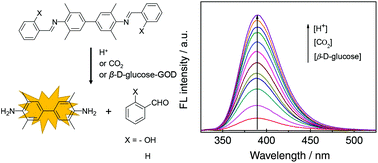Diverse applications of TMB-based sensing probes†
Abstract
Extending the research on 3,3′,5,5′-tetramethylbenzidine (TMB) and its derivatives in analytical chemistry is important, considering that TMB is widely used as an enzyme catalytic substrate. In this work, two TMB derivatives, TMBS and TMBB, were synthesized via a facile and one-step condensation reaction between the –NH2 group of TMB and the –CHO group of salicylaldehyde or benzaldehyde. Because at low pH the two Schiff base compounds can release TMB which can emit strong fluorescence, the probes could show dual-modal signal responses, fluorescence and UV-vis absorption, towards the pH. Practical applications of pH sensing in Chinese rice vinegar and lemon juice samples were successfully demonstrated. On the basis of these findings, a catalytic chromogenic reaction was developed to monitor the pH with the naked eye, too. Furthermore, considering the chemical equilibrium reaction between CO2 and H2O and that glucose oxidase (GOD) can catalyse the dehydrogenation and oxidation reaction of β-D-glucose to produce gluconic acid, both of which can result in lowering the pH values of the two Schiff base systems, highly sensitive and selective dual-modal sensing systems for detecting CO2 and β-D-glucose have also been successfully established. Therefore, the two synthesized TMB derivatives can demonstrate their robust application potential.



 Please wait while we load your content...
Please wait while we load your content...